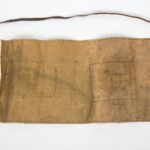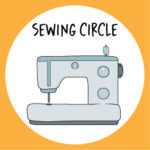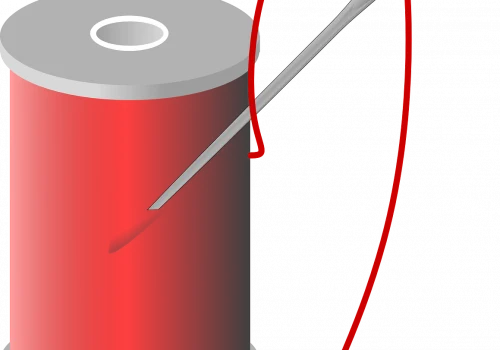Hand Sewing Basics
Learn how to thread a needle, tie a knot and sew a basic running stitch.
Threading a Needle
Hand sewing is lots of fun but there are a few things you need to practice in order to be good at it. The first thing is learning to thread the needle. Needles have a sharp point on one end and an “eye” on the other end. The thread goes through the eye of the needle. It is easy to stick the thread through the eye of a big needle, but if a needle has a very small eye it is much more difficult. Cut a piece of thread about as long as your arm. Pick the needle you are going to use and try to put the thread through the eye of the needle like this:
If the eye of the needle is too small, thread the needle using a needle threader:
Push the wire on the needle threader through the eye of the needle. Put the thread through the end of the wire and use the wire to pull the thread back through the eye of the needle.
When you do hand sewing you can use a single thread or a double thread. A double thread is stronger and doesn’t slip out of the needle. A single thread will slip out of the needle unless you watch it carefully.
To use a double thread, pull the thread through the eye until the needle is in the middle of the thread. Knot the two ends of the thread together and sew.
To use a single thread, pull about 5 inches of thread through the needle. Put a knot at the very end of the long piece of thread. When you sew, make sure you hold the thread as you pull the needle so the short end doesn’t come out of the needle.
Tying a Knot
Tying knots is easier if an adult teaches you how. You can also look at the pictures and try it yourself. Practice until it is easy for you to do.
Hold the thread between your thumb and index finger. Loop it completely around your index finger one time.
Hold the knot between your thumb and index finger and pull the thread with your other hand until the knot is tight.
Hold the thread between your thumb and index finger. Loop it completely around your index finger one time.
Hold the knot between your thumb and index finger and pull the thread with your other hand until the knot is tight.
| Close your thumb and use your thumb to roll the loop of thread toward the end of your index finger. |
| Close your thumb and use your thumb to roll the loop of thread toward the end of your index finger. |
Running Stitch
There are many different kinds of stitches that you can do by hand. The running stitch is very fast and easy. It is good for sewing two pieces of fabric together or for “gathering” fabric. It looks very nice on felt. Create a sample of the running stitch on yellow felt and when done glue it to the Hand Stitch Sample Worksheet in the student packet. Making samples of sewing techniques is a good way to remember how to do it.
The Running Stitch:
Most right handed sewers work from the right side to the left side. (Left handed sewers usually work from the left side to the right side.)
If you think of the little diagram above as the places where your needle goes in and out of the fabric, come up at A, down at B, up at C, down at D, up at E, down at F, up at G and continue that pattern.
| Make the running stitch by bringing the needle up through the fabric and back down again. You can put several stitches on the needle before you pull the thread through. Try to make each of your stitches the same length. Sew for about 4 inches. When you get to the end, take several tiny stitches on top of each other to “lock” the stitches. |
| º | º | º | º | º | º | º |
| G | F | E | D | C | B | A |
| Your finished sample should look like this. |
Try It Out
Pick an activity and try it out as a group or at home

Felt Wallet
Sew two pieces of felt together to make a wallet

Is there a broken link or problem? Report it here.

Help Simply Smart build a community with free resources for families. Share lesson plan ideas!

- Date Added: March 15, 2024


